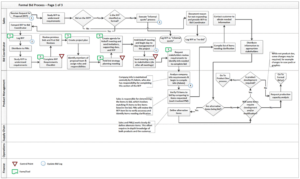Blog
A Short Primer on Process Improvement
Process Improvement (PI) or Business Process Improvement (BPI) is typically used by Industrial Engineers and Consultants to analyze an existing process to determine bottlenecks, waste, inefficiencies or areas of time delay and then develop possible solutions for improving the process.
Examples of improvements could be things such as implementing a new application or system (i.e. ERP systems), changing work processes within or between departments, billing system improvements, sales process improvements and inventory management to name just a few.
Process improvement helps an organization:
- View process value through the eyes of the customer;
- Define, manage, and measure a process in order to regularly evaluate it using data-driven information;
- Break down process silos by contributing to an understanding of how processes interact and impact one another and customers; and
- Reduce unnecessary business costs.
There are several popular examples of process improvement methodologies. Which one to be used is dependent on the organization and its preferences. Different methodologies are employed by external management consulting groups as well.
Examples of methodologies include:
- Six Sigma
- Lean
- Customer Experience Management (CEM)
- Hybrids
There are typically very common parts to each of the methods. There may be different terminology used but the basic flow and concepts tend to be very similar. For example, “As-is” and “To-be” processes are also known as “Current State” and “Future State” processes.
There are plenty of buzz words for each flavor, though when you step back there are some commonalities. PI grew up in the manufacturing world after WW II but has expanded to many industries including the services industry. The ‘Non-Manufacturing Floor PI’ has made its way into many businesses today. Each PI method has strengths and weaknesses and success is dependent on factors such as:
- Executive sponsorship – is this the flavor of the week (see Dilbert cartoons) from the executive team or is this a strategy that has education and funding behind it with a long-term commitment to using the methods?
- Organizational collaboration – do all the people involved in any PI effort want to work together to improve a business process or are they incented to keep in their functional silos?
- Business processes in need of PI – are there significant benefits in spending time and resources to improve a business process? Benefits can include things like adding more capacity without increasing expenses, more timely production of results (speed to market) and reducing overall labor in getting invoices out to clients.
Non-Manufacturing floor PI efforts are also used with new system implementations, organizations that have grown by acquisitions of several different businesses that need to integrate, businesses that have grown dramatically and need new processes, businesses that are preparing for a sale and want to demonstrate additional business value, etc. In all instances, there typically exists a good business case that more than pays for the effort to improve the process.
A recent success story highlights a company that committed to training several of its employees in the Finance/Accounting area in Six Sigma principles. They graduated Yellow Belts (a certification level) from a series of training sessions and used the training itself to focus/practice the learnings on real business issues. The training was a great success and the resulting business improvements more than paid for the external training and for employee ‘lost time’ dedicated to the training. The employees learned new skills and added to their resumes, while the company benefited from the business process improvement and they gained employees that could use their skills on other business processes over the next several years. A true win/win all around.
Want to talk more about using Process Improvement to improve your business and create your own success stories? Give us a call!
– Jim Wadella, Owner – Founder

